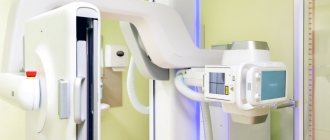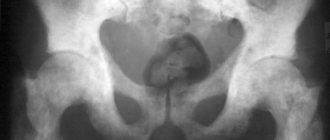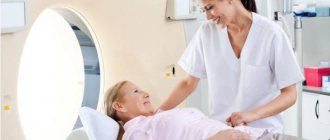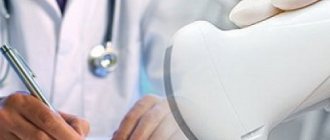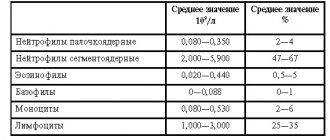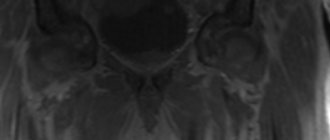Ultrasound examination is one of the most informative, safe and painless methods for diagnosing diseases of the kidneys, bladder and urinary tract. Ultrasound is widely used to examine adults and children, including newborns. Thanks to this technique, the doctor is able to assess the development and condition of the organs of the urinary system in literally 10–15 minutes. An ultrasound of the child’s kidneys is prescribed not only in the presence of certain symptoms, but also as a preventive measure for the timely detection of possible pathologies.
You can undergo an ultrasound examination of the urinary system at a medical clinic. Our specialists work with advanced high-precision equipment, which allows us to obtain reliable results. Examination data is deciphered by doctors of the highest category and candidates of medical sciences. When working with children, we strive to find a common language with them and create a calm, comfortable environment.
Preparation for ultrasound of the bladder in children
In order to properly prepare a child for an ultrasound procedure and ensure high-quality diagnostics, it is necessary to follow a number of mandatory recommendations. One of the most important requirements is the mandatory filling of the bladder with fluid shortly before the start of the diagnosis. To do this, the child drinks from 200 to 500 ml of liquid (still water, compote, tea), depending on age, filling the organ being examined and holding the liquid in it during the entire ultrasound procedure. Visiting the toilet before the child consumes fluids is allowed. You should also refrain from eating milk and foods that can cause the formation of gases in the intestines (honey, fruits, legumes and bread) and thereby complicate an accurate diagnosis. Don’t forget about a good mood, because performing an ultrasound
– it doesn’t hurt at all and is very interesting.
Drinking fluids before diagnosis
The liquid consumed should not be carbonated.
Before the procedure you can drink:
- water;
- weak tea;
- juice;
- compote.
Coffee, milk, fruit drinks (cranberries, lingonberries) and alcohol are prohibited for consumption before ultrasound diagnostics.
The amount of fluid directly depends on the child’s weight. For 1 kg of body weight, you should consume 5-10 ml of liquid.
Infants are examined under the same conditions. The newborn needs to drink water, breast milk or formula at the same rate.
Older girls can take another 0.3-0.5 liters of still water half an hour before diagnosis.
Minimum fluid intake:
- children under 2 years old - at least 0.1 l;
- up to 7 years – at least 0.2 l;
- 8-11 years – at least 0.3 l;
- over 11 years old - at least 0.4 liters.
Conducting a survey
After preparation for the ultrasound is completed, the specialist places the young patient on the couch and, having treated the abdominal area with gel, begins diagnostics using a special scanner. The specialist moves the device over the entire area smoothly, with light pressure, and the image immediately appears on the screen of a small monitor located nearby. Young patients have the opportunity to observe the examination process. Ultrasound results are generated 15-20 minutes after diagnosis and then the patient’s parents are transferred to the doctor for diagnosis.
How to Prepare Based on the Type of Procedure
Ultrasound of the urinary organs in children is performed primarily using the external method. The procedure takes 15-20 minutes. Diagnosis is carried out with a full bladder. Before the examination, the child needs to take liquid 1-1.5 hours. Infants should be given something to drink 20 minutes before the ultrasound.
For the study to be informative, it is necessary to free the intestines from gases in advance.
Children over 2 years of age are not recommended to consume foods that cause gas for 3 days before the test:
- legumes;
- black bread;
- rich baked goods made from wheat flour;
- fresh fruits and vegetables.
At least 18 hours must pass from the last meal to the examination. At night, it is recommended to insert a glycerin suppository into the anus or do an enema. Diagnosis is carried out only with a full bladder, so urinating before the procedure is not allowed.
Transurethral method
The technique is intended for males. The sensor is inserted into the urethra, while the patient is in a supine position. Using this examination, the doctor can evaluate damage to the urethra.
Disadvantages of the study include:
- need for pain relief;
- risk of damage to the genitourinary system by the sensor.
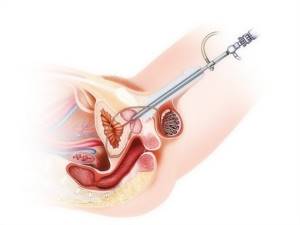
The examination is prescribed in rare cases.
Abdominal
Ultrasound diagnostics occurs through the anterior wall of the abdomen. The study is suitable for girls and boys.
Before diagnosis, the child should undress to the waist. Then you need to lie on the couch on your back. In the area above the pubic bone, the doctor applies a gel to the patient’s skin, along which the sensor will move. The only unpleasant sensations may be the pressure exerted by the device on the outer wall of the abdomen, or the cooling effect of the gel. The child should be warned about this in advance. From the first minutes of diagnosis, an image of the examined organ will begin to be displayed on the monitor.
The doctor will evaluate the shape, thickness of the walls and their size, examine the condition of the mucosa and identify possible pathologies (narrowing of the canal, the presence of stones, helminthic infestations, etc.).
Transvaginal
The method is applicable only to girls who have already had sexual intercourse. An examination is carried out using a vaginal sensor. The procedure is done in a supine position. No preliminary preparation is required before the study. Diagnostics allows us to identify diseases of the reproductive organs.
Transrectal
The examination is carried out through the rectum. The patient removes clothing below the waist and lies on the couch in a lateral position. Diagnostics is used for both sexes. The method is highly informative when compared with the abdominal method.
Decoding the results
The final conclusion based on the ultrasound results is made by a qualified doctor who can give a detailed interpretation of the data obtained and make a diagnosis. He can also prescribe a repeat study if there are doubts about the diagnosis or there is insufficient data. Ultrasound does not cause any harm to the child’s body, so parents do not have to worry about the need to re-examine the child.
Norms for ultrasound of the bladder in children under 1 year of age
Bladder fullness that causes urge
| Child's age, months | Volume, ml |
| 0-3 | 10-20 |
| 3-12 | 25-50 |
The bladder normally has a round shape, its contours are clear, even, and the thickness of the walls is up to 3 mm. The contents in the bladder are anechoic. There is no dilation of the distal ureters.
Norms for ultrasound of the bladder in children 1-3 years old
Bladder fullness that causes urge
| Child's age, years | Volume, ml |
| 1-3 | 50-90 |
Normal indicators for the bladder: clear, even contours, rounded shape, non-thickened walls - 3 mm. The distal parts of the ureters are not dilated. The contents are anechoic.
Norms for ultrasound of the bladder in children 3-7 years old
The fact that ultrasound standards depend on the child’s age and gender is a medical fact, and an experienced diagnostician can quickly compare the data obtained by ultrasound with the standards. If diseases or pathologies are detected, the doctor selects the appropriate treatment, gives the necessary recommendations and prescribes mandatory procedures. Bladder fullness that causes urge
| Child's age, years | Volume, ml |
| 3-7 | 100-150 |
Normally, the bladder has a wall thickness of 3 mm, a round shape, smooth and clear contours. Its contents are anechoic, the distal parts of the ureters are not dilated.
Ultrasound of the urinary system

One of the main diagnostic methods for diseases of the urinary system in children is the ultrasound method. Pediatric ultrasound is a painless, safe and highly informative research method that provides accurate diagnostic results. Using an ultrasound of the urinary system, a child can be diagnosed with circulatory disorders that determine functional kidney disorders, inflammatory processes and neoplasms. Also, pediatric ultrasound is indispensable for dynamic monitoring of small patients with diseases of the urinary system.
What organs are examined during an ultrasound of the genitourinary system in a child?
The organs of the urinary system include: adrenal glands, kidneys, ureters, bladder and urethra.
Sometimes in municipal clinics the queue for such a procedure is scheduled for several weeks, or even months in advance. In our medical center, an ultrasound of the kidneys and bladder can be performed for a child by appointment or, subject to availability, on the day of treatment. You can also call an ultrasound diagnostic doctor to your home and perform an ultrasound on your child at home in a familiar and comfortable environment for the baby, without wasting time on the road. Based on the results of the study, you can make an appointment with a pediatrician, pediatric urologist-andrologist and/or pediatric nephrologist.
Indications for ultrasound of the urinary system
Typically, ultrasound of the kidneys and ultrasound of the bladder for a child are prescribed for the following conditions:
- painful or frequent urination;
- childhood enuresis;
- a decrease in the daily volume of urine or a feeling of incomplete emptying of the bladder in a child;
- painful sensations in the lumbar region, lower abdomen;
- change in the color of urine, the appearance of blood in the child’s urine;
- weakness, fatigue, malaise;
- traumatic injuries of the bladder and urethra;
- swelling in a child;
- urinary tract infections.
What the study reveals
Pediatric ultrasound of the urinary system is an important research method with high diagnostic value. Prescribed by specialists if a child is suspected of having the following pathologies:
- hydronephrosis;
- megaureter;
- urolithiasis;
- abscess, formation of purulent foci;
- nephrosclerosis;
- neoplasms of the kidneys and bladder in children;
- inflammatory diseases: pyelonephritis, cystitis, urethritis, etc.
Preparation for ultrasound diagnostics
To perform an ultrasound of the kidneys, a child does not require special preparation. When performing an ultrasound of the bladder in children, the doctor may recommend that the examination be performed with a full and empty bladder. It is recommended to feed infants half an hour before the ultrasound examination. If you are planning only an ultrasound of the kidneys for an infant, then there are no special recommendations for feeding.
How is an ultrasound examination performed?
An ultrasound of the urinary system is usually performed within 15-20 minutes in the following order:
- 1. The parents undress the child and place him on the couch. The ultrasound doctor applies a special gel, then using a sensor, the examination is carried out.
- 2. When the study is completed, the ultrasound diagnostic doctor draws up a conclusion and passes it on to the parents or attending physician.
- 3. It is important for parents to understand that the child cannot be given a final diagnosis based on ultrasound alone. Therefore, with the conclusion of an ultrasound examination, it is necessary to contact a specialist doctor, who in some cases may prescribe additional tests (urine, blood tests, CT or MRI, etc.)
In our medical center, we perform all types of ultrasound diagnostics for children of any age, including ultrasound of the kidneys for newborns, ultrasound of the bladder for newborns and other types of ultrasound examinations. Ultrasound is performed in the clinic and at home by appointment. Based on the results of the ultrasound, you can make an appointment with a pediatrician, pediatric urologist-andrologist and/or nephrologist.
The medical staff of our medical center are pediatric doctors with many years of practical experience, including in an inpatient setting at one of the best children's hospitals in Russia - the Children's Clinical Hospital named after. N.F. Filatov, where a school for training medical specialists of the highest level has existed for more than 175 years. If necessary, to analyze complex diagnostic cases, we organize a medical consultation with the participation of employees of the departments of pediatric surgery and pediatrics of the Russian National Medical University named after. Pirogov and Children's Clinical Hospital named after. N.F. Filatov (professors, doctors of science, heads of departments).
Advantages of visiting the Children's Health clinic
If you have a question about where to do an ultrasound of the urinary system or an ultrasound of the child’s kidneys, as well as an ultrasound of the bladder, we invite doctors to our medical center in Moscow to conduct a full range of ultrasound examinations for children. Ultrasound doctors with many years of experience + modern expert-class ultrasound equipment provide unsurpassed diagnostic quality.
If, based on the results of an ultrasound and an appointment with a specialist doctor, treatment in a hospital setting is indicated, then the child can be hospitalized in the department of the Filatov Children’s Hospital.
To make an appointment or call a specialist at home, you need to call the specified number, use the feedback form on the center’s website or contact via WhatsApp.
Pathology on ultrasound
Ultrasound is the most informative modern diagnostic method, therefore the detection of pathologies and diseases occurs with fairly high accuracy. Pathologies include the formation of cysts and tumors, noticeable thickening of the bladder walls, and asymmetrical position of the bladder. It should be remembered that even a minor disruption in the functioning of this important organ in a child can cause serious consequences, and in this case, his health will depend on a timely diagnosis and optimally chosen treatment.
Indications for prescribing an ultrasound of the kidneys in a child
An ultrasound examination of the urinary system is most often prescribed after laboratory tests of blood and urine, as well as in the presence of complaints of pain to confirm or clarify the diagnosis. The procedure can be performed at any frequency, since it does not cause radiation exposure to the body.
Kidney ultrasound is part of the newborn screening program. The examination is mandatory for children aged 1–1.5 months. This is due to the fact that about 5% of babies are born with pathologies in the development of the urinary system. Children in their first year of life also need to undergo a kidney ultrasound in the following cases:
- palpable formations in the area of the kidneys and bladder;
- the appearance of edema;
- increased body temperature for no apparent reason;
- renal colic;
- the appearance of blood or mucus in the urine;
- significant fluctuations in the daily volume of fluid excreted.
An ultrasound of the kidneys in an older child may be prescribed if the following symptoms are present:
- swelling of the hands and feet;
- high body temperature without signs of a cold;
- difficulty or painful urination;
- pain in the abdomen and lower back (both for no apparent reason and due to injury);
- high blood pressure;
- enuresis (urinary incontinence);
- change in urine color, etc.
Ultrasound of the brain (neurosonography)
This is a rather unusual study, which can be carried out in an extremely limited period of time - until the fontanelles on the baby’s head close. Fontanas are acoustic windows that, unlike bone tissue, do not interfere with the passage of ultrasonic waves. The large fontanelle usually closes by the end of the first year of life, but in some children this happens earlier - already at the 3-4th month of life. Neurosonography is performed on all children at the age of 1 month. Early ultrasound of the brain makes it possible to study its structure, diagnose possible structural changes (ischemic lesions, cysts, neoplasms, hemorrhages, pathological widening of structures), identify many pathological conditions of the central nervous system before their clinical manifestations, make a diagnosis in time and prescribe adequate treatment, which , in turn, leads to a significant improvement in the prognosis for the life and health of the child.
Preparing for the study. No special preparation is required for neurosonography. It is advisable that the child be active during the study.

